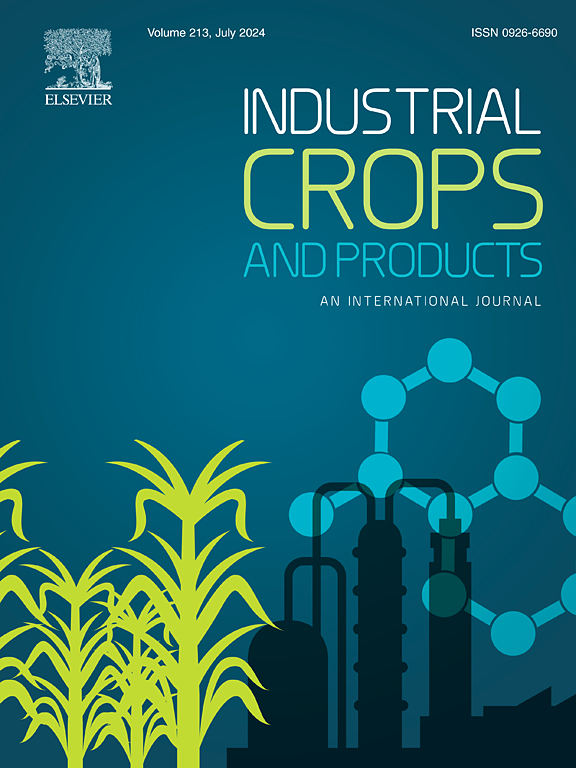Long-term hairy root culture of Centella asiatica (Apiaceae) for enhanced biomass accumulation and centellosides production
IF 5.6
1区 农林科学
Q1 AGRICULTURAL ENGINEERING
引用次数: 0
Abstract
Centella asiatica is a well-known natural rich source of centellosides that possess various medicinal characteristics such as memory enhancement, anti-inflammatory, antioxidant, and wound healing activities. Nowadays, bioprocessing through hairy roots culture (HRC) is considered a proper approach for obtaining valuable specialized compounds. In this study, two hairy root types of C. asiatica, including a wild type (A4), inoculated with Rhizobium (Syn. Agrobacterium) rhizogenes C58C1 (pRiA4) and a transgenic type by R. tumefaciens C58C1 (pRiA4) (pBIs SQS1) carrying the Arabidopsis thaliana squalene synthase (At-SQS) gene were developed in long-term and batch culture systems for biomass accumulation and centellosides production. The highest fresh weight (623.17 ± 11.57 g/L) and dry weight (42.73 ± 0.60 g/L) were obtained for the SQS hairy root line (HRL3) in the long-term period at the eighth week, while in the batch culture system (also maintained for 8 weeks), the peak biomass was observed at the fourth week with maximum FW (243.25 ± 0.22 g/L) and DW (15.60 ± 0.001 g/L). Similar results for the A4 root line were also obtained in the long-term culture at the eighth week. Madecassoside showed the highest accumulation in both culture systems. The highest accumulation (mg/g DW) of madecassoside (4.09 ± 0.04) and total centellosides (5.11 ± 0.134) was observed at the fourth week, asiaticoside (0.57 ± 0.049) at the fifth week, and madecassic acid (0.67 ± 0.024) and asiatic acid (0.65 ± 0.033) at the first week was observed in the long-term system of the HRL3. The production of madecassoside in the SQS hairy root line was 2.67-fold higher than that of the wild type (A4) hairy root line (HRL9). The present results are noteworthy and may be considered for future commercial centellosides production in large-scale bioreactor cultures.

积雪草(Apiaceae)长期毛状根培养促进生物量积累和积雪草苷生产
积雪草是众所周知的天然积雪草苷丰富的来源,具有多种药用特性,如增强记忆、抗炎、抗氧化和伤口愈合活性。目前,毛状根培养(HRC)被认为是获得有价值的特殊化合物的一种合适的方法。本研究利用携带拟南芥角鲨烯合成酶(At-SQS)基因的根际根瘤菌C58C1 (pRiA4)接种的野生型(A4)和根际根瘤菌C58C1 (pRiA4) (pbi SQS1)转基因型(pbi SQS1),在长期和批量培养体系中培养了两种毛状根,用于生物量积累和centel皂苷的生产。最高的鲜重(623.17 ±11.57 g / L)和干重(42.73 ±0.60 g / L)得到的SQS毛状根线(HRL3)长期在第八周,而在批文化系统(也维持8周),峰值最大生物量在第四周观察弗兰克-威廉姆斯(243.25 ±0.22 g / L)和DW(15.60 ±0.001 g / L)。在第八周的长期培养中,A4根线也获得了类似的结果。在两种培养体系中,麻菜苷的积累量最高。最高的积累(毫克/克DW) madecassoside(4.09 ±0.04 )和总centellosides(5.11 ±0.134 )观察四周,asiaticoside(0.57 ±0.049 )在第五周和madecassic酸(0.67 ±0.024 )和积雪草酸(0.65 ±0.033 )在第一周HRL3的长期观察系统。与野生型(A4)毛状根系(HRL9)相比,SQS毛状根系的茄苷产量高出2.67倍。目前的结果是值得注意的,并可能考虑未来在大规模生物反应器培养中商业化生产香茅苷。
本文章由计算机程序翻译,如有差异,请以英文原文为准。
求助全文
约1分钟内获得全文
求助全文
来源期刊

Industrial Crops and Products
农林科学-农业工程
CiteScore
9.50
自引率
8.50%
发文量
1518
审稿时长
43 days
期刊介绍:
Industrial Crops and Products is an International Journal publishing academic and industrial research on industrial (defined as non-food/non-feed) crops and products. Papers concern both crop-oriented and bio-based materials from crops-oriented research, and should be of interest to an international audience, hypothesis driven, and where comparisons are made statistics performed.
 求助内容:
求助内容: 应助结果提醒方式:
应助结果提醒方式:


